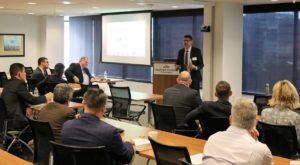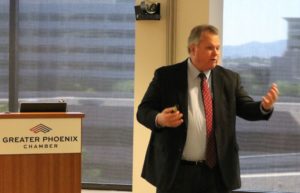
Attendees also heard from Mario Paniagua, Deputy City Manager of the City of Phoenix, who joined Smith to provide an overview of the progress made to date with the City’s Transportation 2050 plan.
Paniagua set the foundation for the event’s dialogue around transportation and transit. The City of Phoenix’s Transportation 2050 connects people to business, education, jobs, and so much more. This multimodal transportation plan aims to move Phoenix forward by advancing the city’s and the region’s economic development efforts that support the growth of business and increasing employment.
Transportation 2050 is a $31 billion, 35-year voter-approved plan and is funded by a .7% sales tax and leverages $14 billion in federal and regional funds, passenger fares, and other funding sources.
In the next 35 years, Transportation 2050 aims to expand bus routes and operational hours; developing 
With a plan of action developed, the City of Phoenix is expanding the available multimodal transportation and transit options. A large component of these plans is Valley Metro, which is the regional public transportation agency providing coordinated transit services to residents of metro Phoenix. From regional bus, light rail and paratransit service to alternative commuter solutions, Valley Metro focuses on connecting communities and enhancing lives through a safe, reliable multimodal transportation system.
Smith, CEO of Valley Metro, addressed the future and economic impact of transit to the region.
“We’re adding 1 million [residents] to Valley in the next 15 years. We’re not building more streets or freeways,” said Smith. “We’ve got to be more efficient and in order to do that you have to use high capacity transit.”
Today, Valley Metro facilitates 32,000 weekly bus routes and services approximately 70 million riders each year.

While light rail construction can be a challenge for existing businesses, Valley Metro and their partners work diligently to provide assistance to those businesses so that they thrive during the construction phase.
In the past decade that the system has been in operation, the region has seen approximately $11 billion in actual construction activity along the rail corridor. According to Scott, developers are building in the region because of light rail.
As the region continues to grow, the City of Phoenix and Valley Metro aim to develop and promote a robust multimodal transportation and transit system that serves the region and promote economic prosperity.
- To learn more about Valley metro, click here
- To learn more about the City of Phoenix’s Transportation 2050 plan, click here
-Written by Miranda Cain-Morton, Development and Communications Manager получить займ на карту
unshaven girl займ карта отличные наличныесрочно нужен займ с плохой кредитной историейзайм под птс сочи займ онлайн в октябрьскомlime-займпосоветуйте займ онлайн займ денег до зарплатывзять займ на карту срочно без отказаонлайн займ за 5 минут

